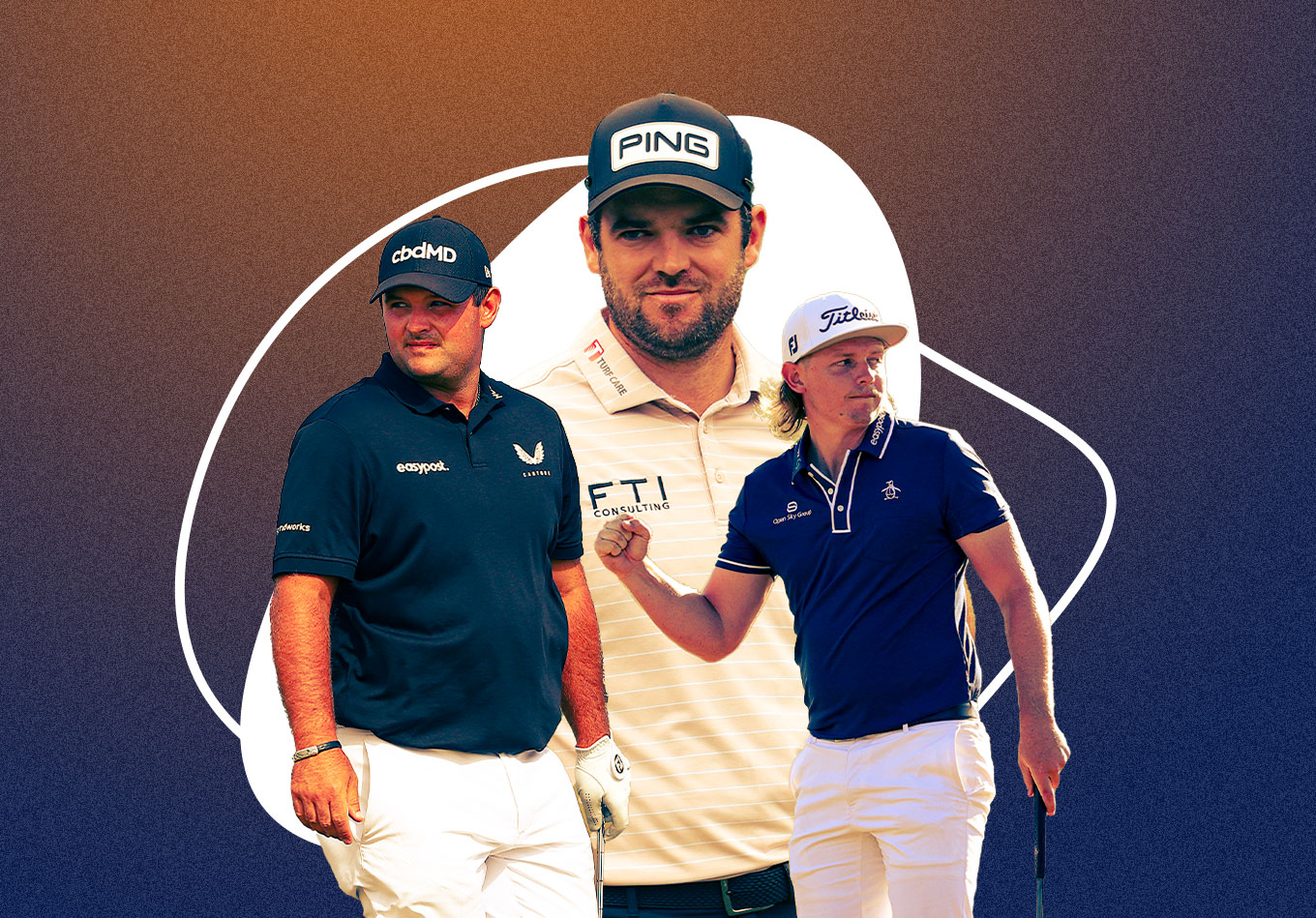We’re using the advanced FRACAS model to project the winner, best value picks and top fantasy plays ahead of this weekend’s PGA Championship.
FRACAS has evolved.
Our focal point of research since we introduced FRACAS has been how we describe hole types. Previously, we split holes into short par 3s, long par 3s, short par 4s, long par 4s, and par 5s. While a reasonable categorization, we felt there were elements missing from these classifications that could better describe golfer style.
The result is eight classifications of holes: two types of par 3s and par 5s, and four types of par 4s. Each class, on average, appears one or more times per golf course.
FRACAS: New Hole Classifications
| Description | Par | Yardage | Avg. Score | Standard Dev. |
|---|---|---|---|---|
| Easy Par 3s | 3 | 179 | 2.97 | 0.35 |
| Difficult Par 3s | 3 | 213 | 3.21 | 0.46 |
| Short/Easy Par 4s | 4 | 376 | 3.79 | 0.46 |
| Short/Diff Par 4s | 4 | 408 | 4.01 | 0.38 |
| Long/Easy Par 4s | 4 | 462 | 3.98 | 0.38 |
| Long/Diff Par 4s | 4 | 461 | 4.25 | 0.51 |
| Easy Par 5s | 5 | 554 | 4.53 | 0.59 |
| Difficult Par 5s | 5 | 584 | 4.91 | 0.53 |
The important thing to recognize about this classification is there are no hard cutoffs. Holes are categorized based on par, yardage and average score, which means there are yardage overlaps between different clusters. For instance, the two long par-4 classes come in at almost the same yardage but are differentiated by average score.
It’s not a massive overhaul over our previous methodology, but being able to include hole difficulty when considering what type of hole is being played is valuable.
This Week
The Ocean Course at Kiawah Island Golf Resort is the host for the 2021 PGA Championship. The white-line yardage is 7,876, making it the longest course ever played for a major. The length is everywhere, but where it rears its ugliest head is on the long par 4s. Holes 6, 9, 10, 13 and 18 are all par 4s that are long and difficult. When this course was played for the 2012 PGA Championship, those five holes played a combined 1.65 over par. However, we expect them to play a little easier this time around, as Round 2 in 2012 was brutalized by wind, something that is not in the forecast this year.
The wind will be a constant point of discussion this week. Located on the Atlantic Ocean, there is no prevailing wind on Kiawah Island. If the wind picks up, it will cause havoc. On the windiest day in 2012, the course played more than 6.0 strokes over par.
The field is predictably strong for the second major of the year. There are 156 golfers in the field, with 20 spots claimed by PGA professionals from around the country, another couple dozen coming from leaders on international tours and the rest coming from the top 100 players in the world or winners on the PGA Tour in the last year. It’s rare for any of the 20 PGA pros to make any noise, so really we’re looking at 135 or so viable options. Additionally, the cut will be top 70 and ties, so the likelihood of a strong weekend field is high. This is in stark contrast to the last two tournaments, which have had weaker weekend fields due to a large field and a selective cut line.
For such a long course, it’s easy to assume that the players who can hit it the furthest hold an advantage. However, we’ve seen that length is of greater importance when a course is long and easy. When it is long and difficult, the players who succeed are the ones who can scramble. Elite short game will be key for us this week.
Let’s take a closer look at the expected scores for each hole below. Red holes are expected to play harder while the dark purple holes are expected to play easier:
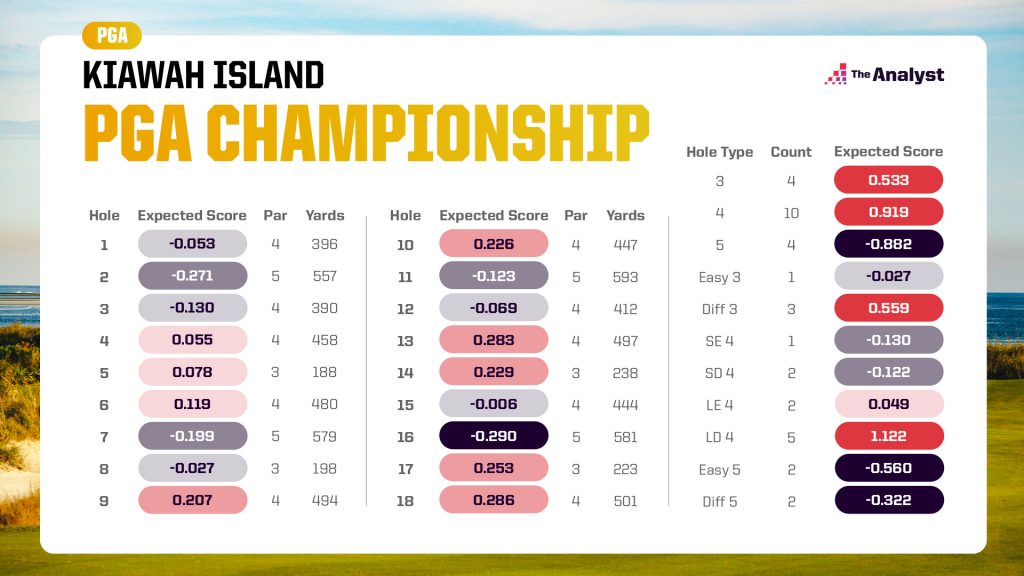
Below, the holes with the most variance are darker than the ones with less variance. So the darker holes are essentially the ones on which players have the greatest opportunities to distance themselves from the field – or lose plenty of ground in a hurry.
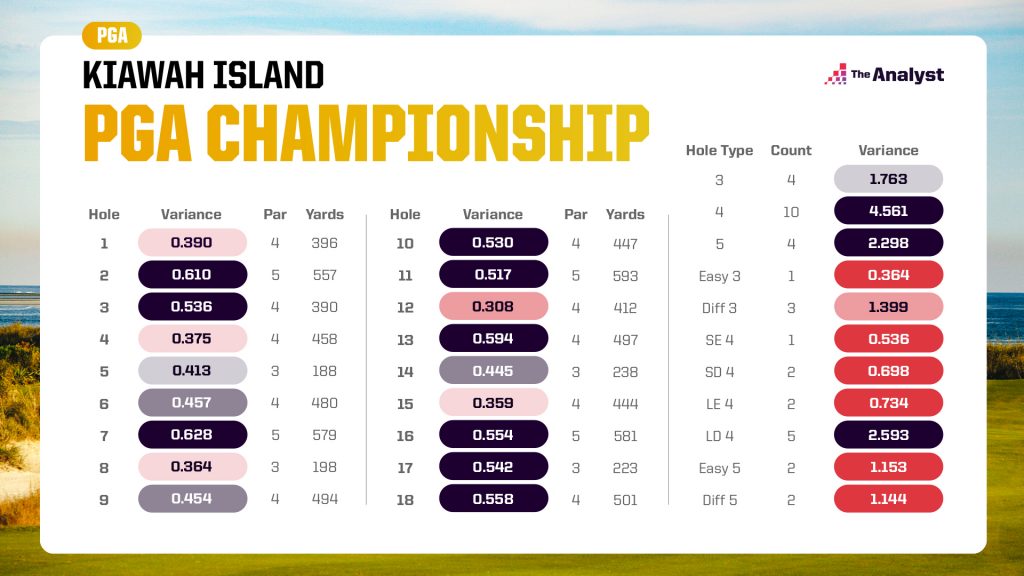
The Model’s Picks
As we discuss every week, there is a difference between who we think will win, and who we think is a good value relative to the market. This week, however, both our pick to win and our highest value converge on one golfer.
Typically, our model aligns with the consensus odds on a winner, or at least projects a winner from somewhere on the top of the betting board. This week is different. Our model projects Australian Cameron Smith as the champion. He leads our simulations at 6.10%. Smith is coming in on fire, with five top 20s in his last five stroke-play tournaments.
While that doesn’t sound terribly impressive for someone we’d project to win, those six tournaments were The Genesis, WGC-Workday, THE PLAYERS, the Masters and RBC Heritage. All of those tournaments were filled with elite players. He also took home the trophy at the Zurich, a team event that he won with Marc Leishman.
He has been flying up the FRACAS board lately and now sits fifth in our global FRACAS rankings. The plot below shows how Smith’s FRACAS has steadily increased since the start of 2020. And while there was a little blip at the start of 2021, he’s since righted the ship.
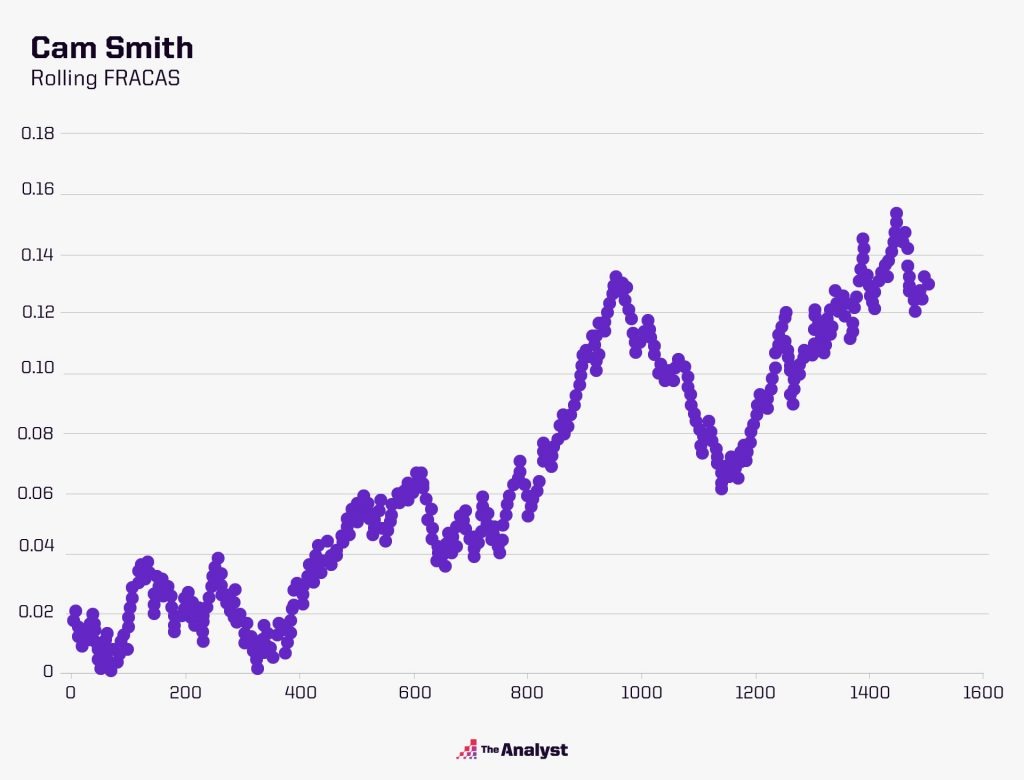
The course is a perfect fit for Smith. He gains the most strokes on long par 3s, long/difficult par 4s and difficult par 5s. On the Ocean Course, that’s 10 out of 18 holes where he’s playing his most comfortable golf. It’s Cam Smith’s time, and we have him as 16-1 to win.
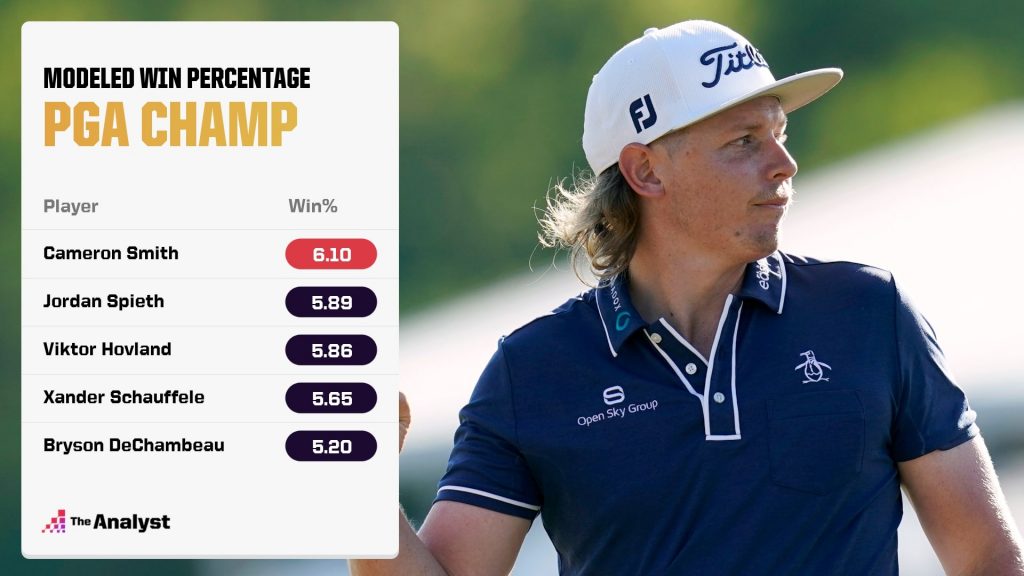
The Model’s Value Plays
The focus will be on difficult par 4s and scrambling this weekend and Patrick Reed is the king of the long and difficult. Per FRACAS, there is no one better in the world right now on long, difficult par 4s. He’s currently 14th in the world overall per FRACAS, but on this course, he jumps 13 golfers to second in the field. That’s almost entirely because of how he dominates those long difficult holes. He projects to play well on all the hole types this week, but his value comes from being able to save par when things get tough. We put Reed at 20-1 to win.
Hole-in-one machine Corey Conners bucks a little of our short-game trend, but his current form is among the strongest in the field at the moment. FRACAS puts him at 11th overall in the field in spite of projecting him for 27th in the field on the long difficult par 4s. Where he can pick up strokes is on the four difficult par 3s, the three short difficult par 4s and the difficult par 5s. He’s surprisingly average when things are easy, but on difficult tracks, he shines, and this course should be difficult. His tee-to-green stats are absurd, averaging over 6.0 strokes gained in his last 10 tournaments. Conners has been among the best in the world in 2021 and the model likes him here at 28-1.
There are a few longshots we like as well this week, starting with Brian Harman. Harman has finished in the top 20 in his last five tournaments and the difficult course suits him. It suits him so much that he gets the highest course adjustment among all golfers in the field. Specifically, it’s performance on long, difficult par 4s and 5s. In this loaded field, Harman projects to score sixth best on the long difficult par 4s and 14th on the long difficult par 5s. His short game is among the best in the world and it’s been even better of late, averaging 6.1 strokes gained with his short game over his last five tournaments. Our model puts him at an astounding 42-1.
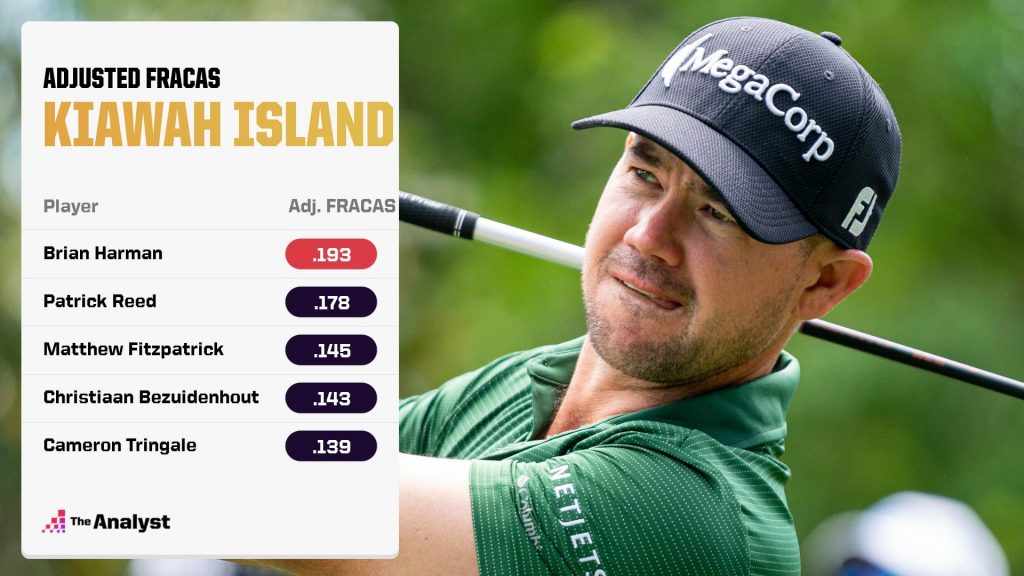
Looking even deeper on the board, we also like the prospects of Christiaan Bezuidenhout. Like Smith, Reed, and Harman, Bezuidenhout really excels when the going gets tough. The consensus odds put him at 132-1, but our model likes him at half those odds at 68-1. If the course plays easy, Bezuidenhout’s prospects likely plummet, but it would be a shocker if the winner scores better than 17-under par, which is the type of tournament where Bez can excel.
While fellow South Africans Dean Burmester and Daniel Van Tonder are favorites of the model, Japan Tour golfers Chan Kim, Takumi Kanaya, and Rikuya Hoshino are all coming in with excellent form. Kim, the American in the trio, projects to golf the best this week because of the course fit. The 25-year-old Hoshino has three wins in his last 11 Japan Golf Tour starts. He excels more on shorter courses, so this probably isn’t the best course for him.
The 22-year-old Kanaya has won three times in the last three years, but that’s a win rate of 14%. He played in the Sony Open on the PGA Tour and two Euro events to start 2021, missing the cut on the number at Sony and finishing tied for ninth and 53rd in the two Euro events. While this isn’t the course he’ll play his best at, he currently sits 48th in the world overall by FRACAS. He’s qualified for a number of international tournaments this year and is a player on the rise.
DraftKings GPP Value Plays
Our model also simulates DraftKings results. This is an important distinction, as DraftKings points are driven both by finishing position and hole scoring, so players like Tony Finau who make a lot of birdies while also making some bogeys may be better DraftKings plays than players like Charles Howell III, who has a great chance to make the cut, but doesn’t score much.
We’ll go through each salary grouping and identify players we see as being underpriced relative to value and those players who are around them. Generally we’ll identify around 25 players we like, though that number can change depending on the size of the field.
With high scores projected this week, placement points will be a large portion of Draftkings scoring this week. We’re looking for golfers who have the best chance to finish inside the top 20. With the pricing structure this week, there is a small group of $8,000+ golfers we’ll be all-in on, while filling out lineups with a plethora of lower priced options.
$9,000+
- Jon Rahm $10,500
- Bryson DeChambeau $10,200
- Jordan Spieth $10,100
- Xander Schauffele $9,600
- Viktor Hovland $9,300
- Patrick Reed $9,100
$8,000+
- Cameron Smith $8,900
- Tony Finau $8,600
- Matthew Fitzpatrick $8,400
- Louis Oosthuizen $8,000
- Tyrrell Hatton $8,000
$7,000+
- Abraham Ancer $7,900
- Joaquin Niemann $7,800
- Paul Casey $7,700
- Corey Conners $7,600
- Sergio Garcia $7,600
- Sam Burns $7,500
- Brian Harman $7,400
- Matt Wallace $7,400
- Charley Hoffman $7,300
- Max Homa $7,300
- Keegan Bradley $7,300
- Billy Horschel $7,200
- Jason Kokrak $7,100
- Cameron Tringale $7,100
- Matt Jones $7,100
- Emiliano Grillo $7,000
- Chris Kirk $7,000
$6,000+
- Stewart Cink $6,900
- Christiaan Bezuidenhout $6,800
Design by Matt Sisneros.
